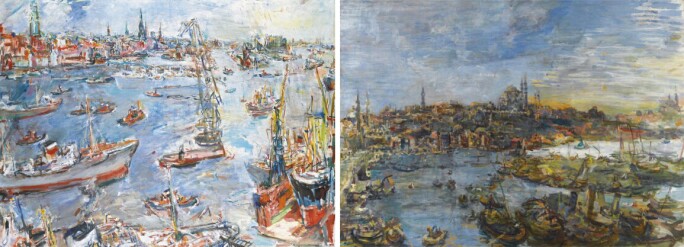The 1920s were an important decade for Kokoschka. Having exhibited in the German Pavilion at the 1922 Venice Biennale, he began to gain recognition for his work not only in Germany but across Europe. These developments were further enriched by his extensive travels throughout the decade, during which he visited several European countries in addition to journeys to North Africa and the Middle East. It was during this period that he consolidated many key aspects of his mature work, most notably in his approach to landscapes.
Dating from 1926, Hamburg, Binnenalster / Jungfernstieg exemplifies these changes during his early period of travelling. Taking in the Binnenalster lake and main promenade at the centre of Hamburg, the work conjures a vivid portrait of the city. Kokoschka moved away from the thickly applied oils of his earlier work, diluting the pigment with turpentine to facilitate quicker execution. The result is a looser, more immediate style, marked by a subtle use of colour and a harmo
‘…they are at their best paintings which capture the very feel of life itself…’
This new technique was combined with a number of important compositional innovations that reveal Kokoschka’s very modern approach to painting. As Richard Calvocoressi notes of works from this decade: ‘Whenever he could, Kokoschka preferred to look down on his motif from a high viewpoint, climbing to the top of a hill or the tenth floor of a building in order to achieve maximum breadth and distance. He also adopted the unusual technique of painting the same subject from two different viewpoints, allowing him, as he later recalled, to “double the width of my visual field.” This dual perspective contributes to the slightly spherical composition of many of his townscapes, reminiscent of a wide-angle photograph, and creates a sense of spinning motion that prevents the eye from settling on a single focal point, giving equal importance to the periphery of vision. In short, these are paintings at their best, works that capture the very essence of life itself. Even Kokoschka’s buildings, it has been said, 'grow, move, and breathe' (Richard Calvocoressi, in Exh. Cat., Oskar Kokoschka, London, Tate, 1986, p. 112)."
These cityscapes would remain an important part of Kokoschka’s work. He returned to Hamburg numerous times over the following decade, capturing many views of the city (see fig. 1).

He often focused on the bustling life of post-industrial waterways in these locations, an environment familiar to him from his own travels across Europe. These settings also revealed one of the city's most compelling aspects: a point of intersection between past and present. In this respect, his cityscapes can be seen as portraits of the Europe that emerged in the aftermath of the First and Second World Wars. As Werner Hofmann explains: ‘in his portraits of cities, Kokoschka transforms the given topographies into living beings, mixing the charm of age with a permanent rejuvenation’ (Werner Hofmann, in Oskar Kokoschka (exhibition catalogue), Galerie des Beaux-Arts, Bordeaux, 1983, p. 23, translated from French). This is especially true of the present work, which blends the ancient architecture of the old city with the immediacy of a moment caught in time, capturing the vibrancy and energy of the modern world.

Right: Fig. 3: Oskar Kokoschka, Istanbul I, sold at Sotheby’s London, 3 February 2009 for: 1,497,250 GBP

